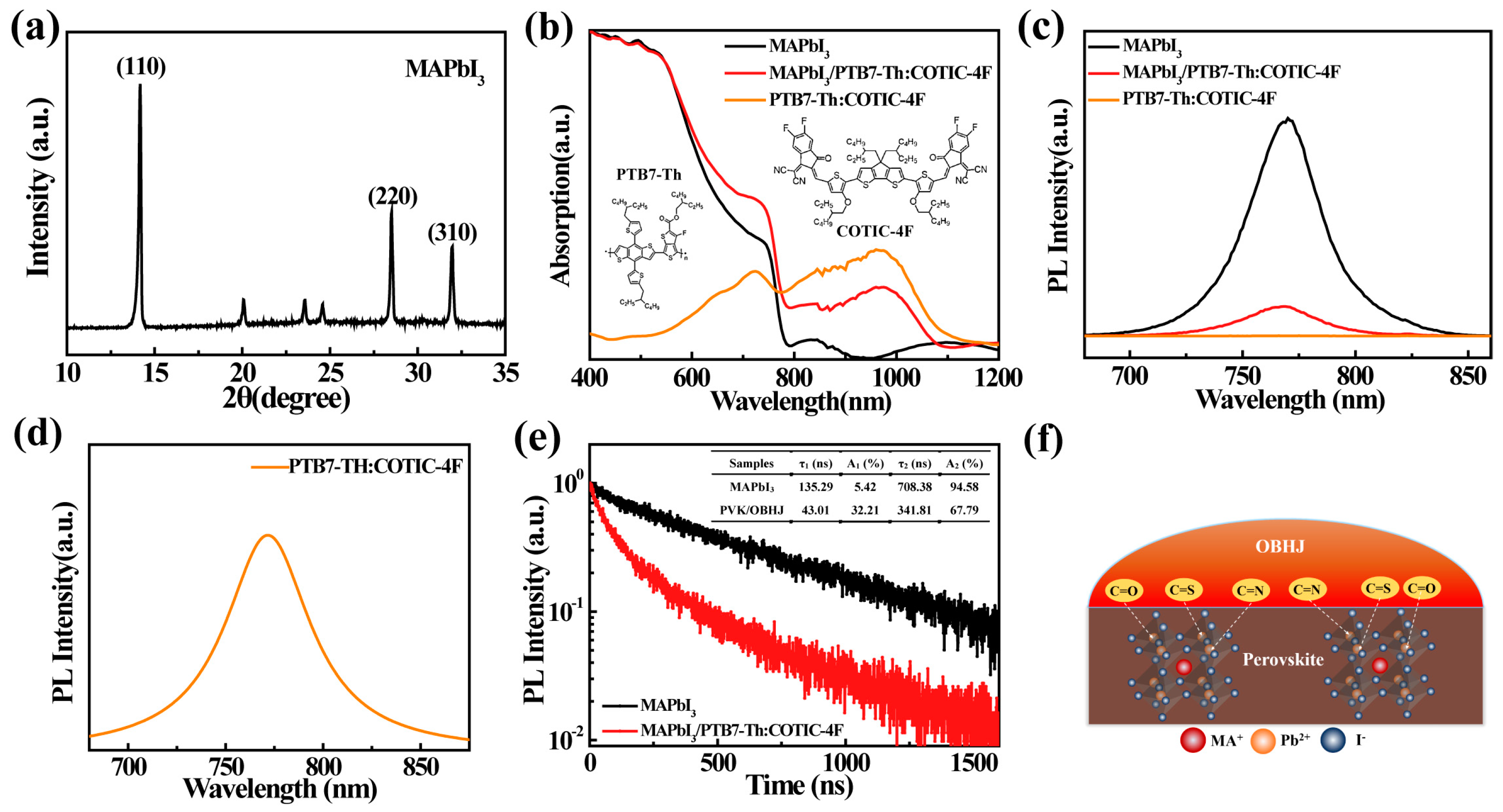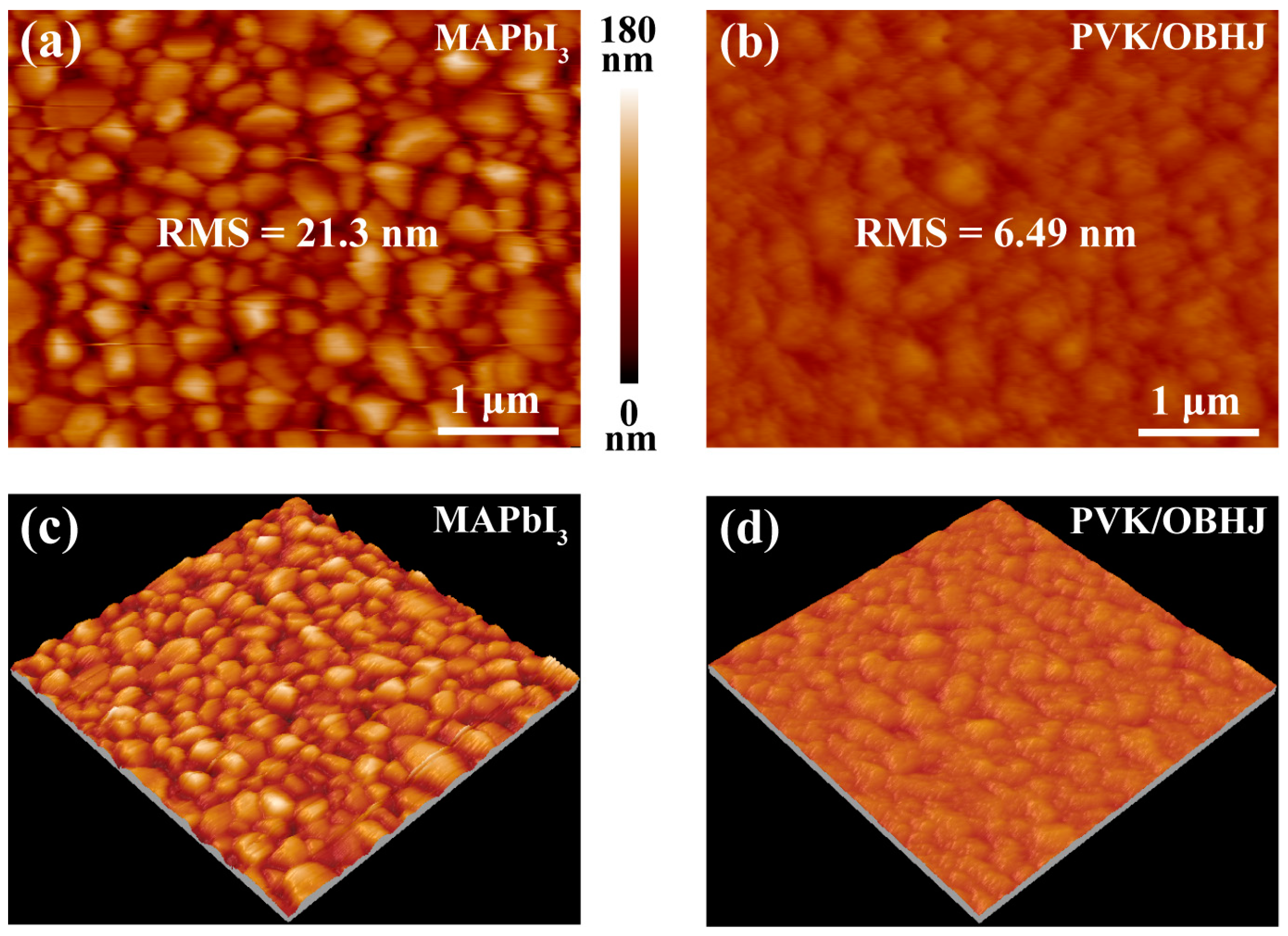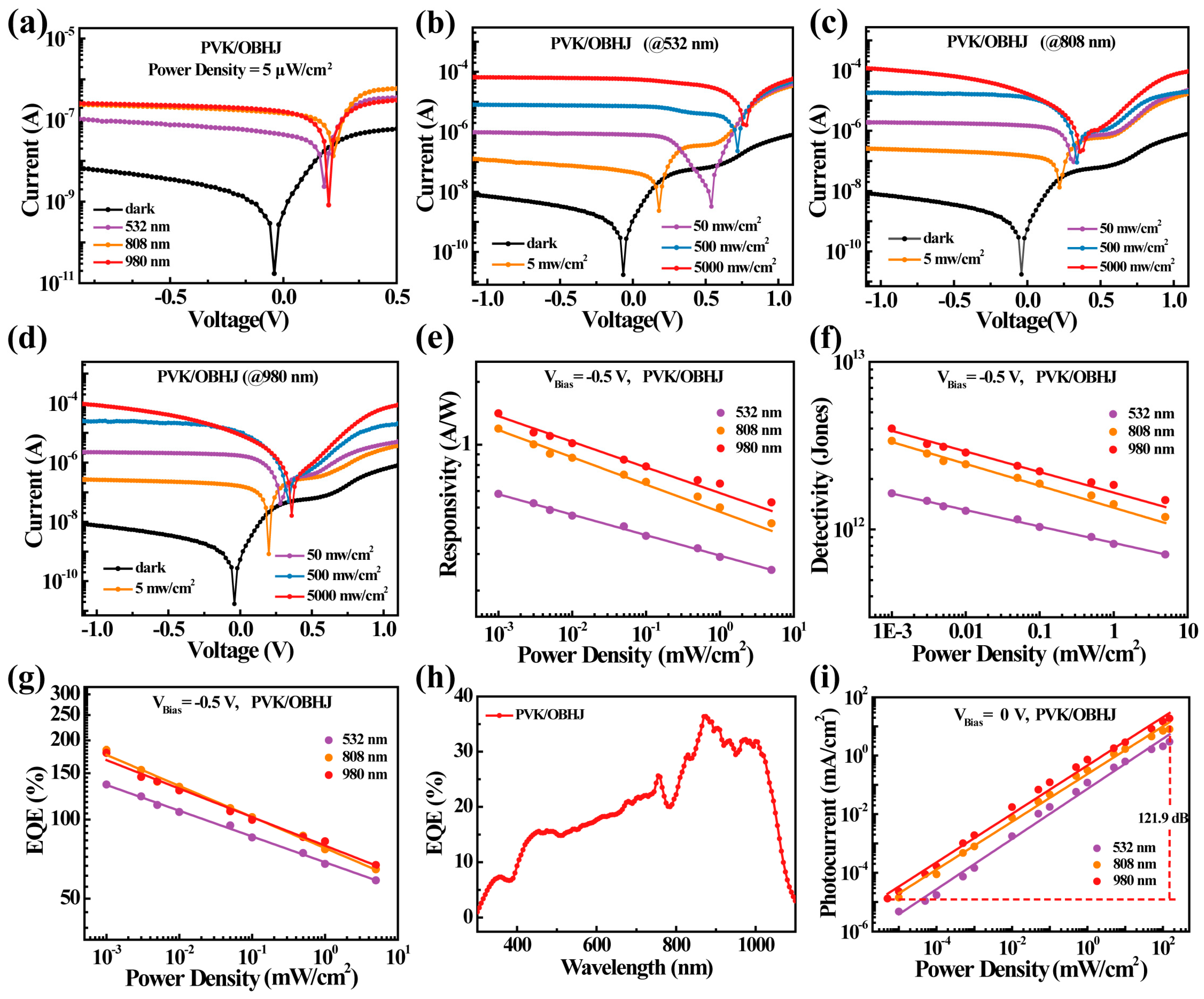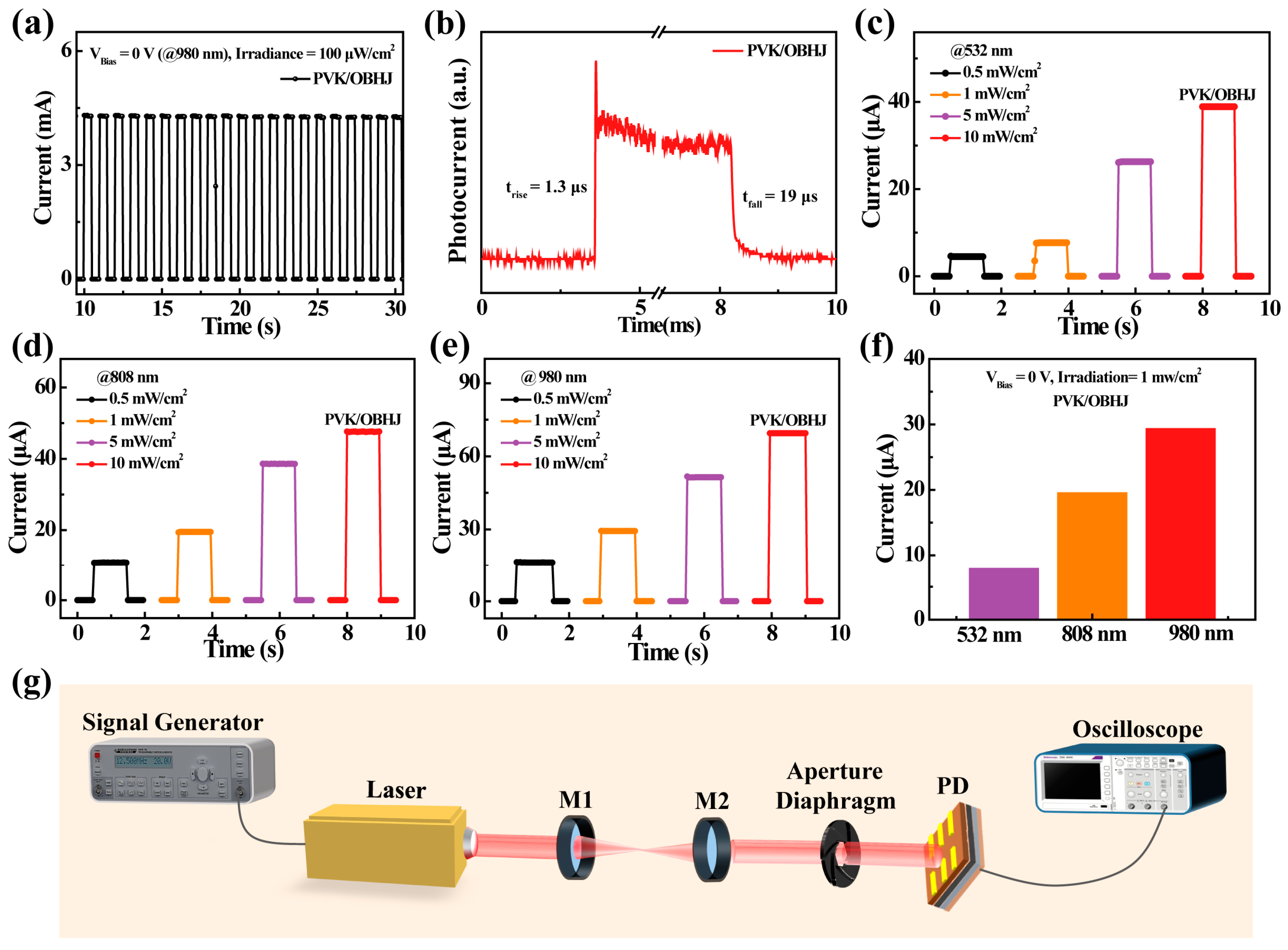High-Performance Broadband Photodetectors Combining Perovskite and Organic Bulk Heterojunction Bifunctional Layers
Abstract
1. Introduction
2. Materials and Methods
2.1. Material Preparation
2.2. Device Fabrication
2.3. Characterization
3. Results and Discussion
4. Conclusions
Author Contributions
Funding
Data Availability Statement
Conflicts of Interest
References
- Dou, L.; Yang, Y.M.; You, J.; Hong, Z.; Chang, W.H.; Li, G.; Yang, Y. Solution-Processed Hybrid Perovskite Photodetectors with High Detectivity. Nat. Commun. 2014, 5, 5404. [Google Scholar] [CrossRef] [PubMed]
- Kelley, S.O.; Mirkin, C.A.; Walt, D.R.; Ismagilov, R.F.; Toner, M.; Sargent, E.H. Advancing the Speed, Sensitivity and Accuracy of Biomolecular Detection Using Multi-Length-Scale Engineering. Nat. Nanotechnol. 2014, 9, 969–980. [Google Scholar] [CrossRef] [PubMed]
- Armin, A.; Jansen-van Vuuren, R.D.; Kopidakis, N.; Burn, P.L.; Meredith, P. Narrowband Light Detection Via Internal Quantum Efficiency Manipulation of Organic Photodiodes. Nat. Commun. 2015, 6, 6343. [Google Scholar] [CrossRef]
- Li, T.; Li, Q.; Tang, X.; Chen, Z.; Li, Y.; Zhao, H.; Wang, S.; Ding, X.; Zhang, Y.; Yao, J. Environment-Friendly Antisolvent Tert-Amyl Alcohol Modified Hybrid Perovskite Photodetector with High Responsivity. Photonics Res. 2021, 9, 781–791. [Google Scholar] [CrossRef]
- Li, G.; Li, S.; Ahmed, J.; Tian, W.; Li, L. Flexible Perovskite Photodetector with Room-Temperature Self-Healing Capability without External Trigger. InfoMat 2024, e12594. [Google Scholar] [CrossRef]
- Jing, H.; Peng, R.; Ma, R.M.; He, J.; Zhou, Y.; Yang, Z.; Li, C.Y.; Liu, Y.; Guo, X.; Zhu, Y.; et al. Flexible Ultrathin Single-Crystalline Perovskite Photodetector. Nano Lett. 2020, 20, 7144–7151. [Google Scholar] [CrossRef]
- Cheng, W.; Tian, W.; Cao, F.; Li, L. Self-Powered Bifunctional Perovskite Photodetectors with Both Broadband and Narrowband Photoresponse. InfoMat 2022, 4, e12348. [Google Scholar] [CrossRef]
- Huang, R.; Wu, K.; Li, W.; Huang, X.; Zhou, S.; Jiang, S.; Fu, Y.; Zhao, Z.; Mai, W.; Zhao, C. Sunflower-Inspired Light-Tracking System and Spatial Encryption Imaging Based on Linear Flexible Perovskite Photodetector Arrays. Adv. Opt. Mater. 2023, 11, 2301177. [Google Scholar] [CrossRef]
- Li, S.; Xie, X.; Huang, F.; Shu, L.; Liu, L.; Wang, C.; Yang, Y.; Li, R. Recent Application and Progress of Metal Halide Perovskite Photodetector on Flexible Substrates. Chin. J. Chem. 2023, 41, 3689–3702. [Google Scholar] [CrossRef]
- Yu, D.; Cao, F.; Gu, Y.; Han, Z.; Liu, J.; Huang, B.; Xu, X.; Zeng, H. Broadband and Sensitive Two-Dimensional Halide Perovskite Photodetector for Full-Spectrum Underwater Optical Communication. Nano Res. 2020, 14, 1210–1217. [Google Scholar] [CrossRef]
- Waleed, A.; Tavakoli, M.M.; Gu, L.; Wang, Z.; Zhang, D.; Manikandan, A.; Zhang, Q.; Zhang, R.; Chueh, Y.L.; Fan, Z. Lead-Free Perovskite Nanowire Array Photodetectors with Drastically Improved Stability in Nanoengineering Templates. Nano Lett. 2017, 17, 523–530. [Google Scholar] [CrossRef] [PubMed]
- Zhu, H.L.; Liang, Z.; Huo, Z.; Ng, W.K.; Mao, J.; Wong, K.S.; Yin, W.J.; Choy, W.C.H. Low-Bandgap Methylammonium-Rubidium Cation Sn-Rich Perovskites for Efficient Ultraviolet–Visible–near Infrared Photodetectors. Adv. Funct. Mater. 2018, 28, 1706068. [Google Scholar] [CrossRef]
- Chang, Z.; Lu, Z.; Deng, W.; Shi, Y.; Sun, Y.; Zhang, X.; Jie, J. Narrow-Bandgap Sn-Pb Mixed Perovskite Single Crystals for High-Performance near-Infrared Photodetectors. Nanoscale 2023, 15, 5053–5062. [Google Scholar] [CrossRef] [PubMed]
- Gao, W.-H.; Chen, C. Perovskites and Their Constructed near-Infrared Photodetectors. Nano Energy 2024, 128, 109904. [Google Scholar] [CrossRef]
- Wang, W.; Zhao, D.; Zhang, F.; Li, L.; Du, M.; Wang, C.; Yu, Y.; Huang, Q.; Zhang, M.; Li, L.; et al. Highly Sensitive Low-Bandgap Perovskite Photodetectors with Response from Ultraviolet to the near-Infrared Region. Adv. Funct. Mater. 2017, 27, 1703953. [Google Scholar] [CrossRef]
- Cheng, W.; Wu, S.; Lu, J.; Li, G.; Li, S.; Tian, W.; Li, L. Self-Powered Wide-Narrow Bandgap-Laminated Perovskite Photodetector with Bipolar Photoresponse for Secure Optical Communication. Adv. Mater. 2024, 36, 2307534. [Google Scholar] [CrossRef]
- Zhu, H.L.; Lin, H.; Song, Z.; Wang, Z.; Ye, F.; Zhang, H.; Yin, W.J.; Yan, Y.; Choy, W.C.H. Achieving High-Quality Sn-Pb Perovskite Films on Complementary Metal-Oxide-Semiconductor-Compatible Metal/Silicon Substrates for Efficient Imaging Array. ACS Nano 2019, 13, 11800–11808. [Google Scholar] [CrossRef]
- Cao, F.; Chen, J.; Yu, D.; Wang, S.; Xu, X.; Liu, J.; Han, Z.; Huang, B.; Gu, Y.; Choy, K.L.; et al. Bionic Detectors Based on Low-Bandgap Inorganic Perovskite for Selective Nir-I Photon Detection and Imaging. Adv. Mater. 2020, 32, 1905362. [Google Scholar] [CrossRef]
- Chen, T.; Liu, Z.; Zhang, L.; Wu, H.; Wu, G.; Chen, H. Visible-Blind Narrowband near-Infrared Photodetector for Precise Real-Time Photoplethysmography Measurement. ACS. Appl. Mater. Interfaces 2023, 15, 50312–50320. [Google Scholar] [CrossRef]
- Siddik, A.B.; Georgitzikis, E.; Hermans, Y.; Kang, J.; Kim, J.H.; Pejovic, V.; Lieberman, I.; Malinowski, P.E.; Kadashchuk, A.; Genoe, J.; et al. Interface-Engineered Organic near-Infrared Photodetector for Imaging Applications. ACS. App. Mater. Interfaces 2023, 15, 30534–30542. [Google Scholar] [CrossRef]
- Piper, S.K.; Krueger, A.; Koch, S.P.; Mehnert, J.; Habermehl, C.; Steinbrink, J.; Obrig, H.; Schmitz, C.H. A Wearable Multi-Channel Fnirs System for Brain Imaging in Freely Moving Subjects. Neuroimage 2014, 85, 64–71. [Google Scholar] [CrossRef] [PubMed]
- Yokota, T.; Zalar, P.; Kaltenbrunner, M.; Jinno, H.; Matsuhisa, N.; Kitanosako, H.; Tachibana, Y.; Yukita, W.; Koizumi, M.; Someya, T. Ultraflexible Organic Photonic Skin. Sci. Adv. 2016, 2, 1501856. [Google Scholar] [CrossRef] [PubMed]
- Shou, K.; Qu, C.; Sun, Y.; Chen, H.; Chen, S.; Zhang, L.; Xu, H.; Hong, X.; Yu, A.; Cheng, Z. Multifunctional Biomedical Imaging in Physiological and Pathological Conditions Using a Nir-II Probe. Adv. Funct. Mater. 2017, 27, 1700995. [Google Scholar] [CrossRef]
- Wang, H.; Liu, H.; Zhao, Q.; Ni, Z.; Zou, Y.; Yang, J.; Wang, L.; Sun, Y.; Guo, Y.; Hu, W.; et al. A Retina-Like Dual Band Organic Photosensor Array for Filter-Free near-Infrared-to-Memory Operations. Adv. Mater. 2017, 29. [Google Scholar] [CrossRef] [PubMed]
- Wu, G.; Fu, R.; Chen, J.; Yang, W.; Ren, J.; Guo, X.; Ni, Z.; Pi, X.; Li, C.Z.; Li, H.; et al. Perovskite/Organic Bulk-Heterojunction Integrated Ultrasensitive Broadband Photodetectors with High near-Infrared External Quantum Efficiency over 70. Small 2018, 14, 1802349. [Google Scholar] [CrossRef]
- Li, C.; Wang, H.; Wang, F.; Li, T.; Xu, M.; Wang, H.; Wang, Z.; Zhan, X.; Hu, W.; Shen, L. Ultrafast and Broadband Photodetectors Based on a Perovskite/Organic Bulk Heterojunction for Large-Dynamic-Range Imaging. Light Sci. Appl. 2020, 9, 31. [Google Scholar] [CrossRef]
- Luong, H.M.; Kaiyasuan, C.; Yi, A.; Chae, S.; Kim, B.M.; Panoy, P.; Kim, H.J.; Promarak, V.; Miyata, Y.; Nakayama, H.; et al. Highly Sensitive Resonance-Enhanced Organic Photodetectors for Shortwave Infrared Sensing. ACS Energy Lett. 2024, 9, 1446–1454. [Google Scholar] [CrossRef]
- Sakai, N.; Pathak, S.; Chen, H.-W.; Haghighirad, A.A.; Stranks, S.D.; Miyasaka, T.; Snaith, H.J. The Mechanism of Toluene-Assisted Crystallization of Organic–Inorganic Perovskites for Highly Efficient Solar Cells. J. Mater. Chem. A 2016, 4, 4464–4471. [Google Scholar] [CrossRef]
- Xu, X.; Li, Z.; Zhu, L.; Zheng, H.; Liu, G.; Hayat, T.; Alsaedi, A.; Zhang, X.; Huang, Y.; Pan, X. Large-Grained Formamidinium-Based Films Via a 2d–3d Conversion Mechanism for High-Performance Perovskite Solar Cells without Anti-Solvent. J. Mater. Chem. A 2019, 7, 1341–1348. [Google Scholar] [CrossRef]
- Li, C.; Lu, J.; Zhao, Y.; Sun, L.; Wang, G.; Ma, Y.; Zhang, S.; Zhou, J.; Shen, L.; Huang, W. Highly Sensitive, Fast Response Perovskite Photodetectors Demonstrated in Weak Light Detection Circuit and Visible Light Communication System. Small 2019, 15, e1903599. [Google Scholar] [CrossRef]
- Li, F.; Ma, C.; Wang, H.; Hu, W.; Yu, W.; Sheikh, A.D.; Wu, T. Ambipolar Solution-Processed Hybrid Perovskite Phototransistors. Nat. Commun. 2015, 6, 8238. [Google Scholar] [CrossRef] [PubMed]
- Yan, F.; Wei, Z.; Wei, X.; Lv, Q.; Zhu, W.; Wang, K. Toward High-Performance Photodetectors Based on 2d Materials: Strategy on Methods. Small Methods 2018, 2, 1700349. [Google Scholar] [CrossRef]
- Buscema, M.; Island, J.O.; Groenendijk, D.J.; Blanter, S.I.; Steele, G.A.; van der Zant, H.S.; Castellanos-Gomez, A. Photocurrent Generation with Two-Dimensional Van Der Waals Semiconductors. Chem. Soc. Rev. 2015, 44, 3691–3718. [Google Scholar] [CrossRef] [PubMed]
- Chen, S.; Teng, C.; Zhang, M.; Li, Y.; Xie, D.; Shi, G. A Flexible Uv-Vis-Nir Photodetector Based on a Perovskite/Conjugated-Polymer Composite. Adv. Mater. 2016, 28, 5969–5974. [Google Scholar] [CrossRef] [PubMed]
- Shen, L.; Lin, Y.; Bao, C.; Bai, Y.; Deng, Y.; Wang, M.; Li, T.; Lu, Y.; Gruverman, A.; Li, W.; et al. Integration of Perovskite and Polymer Photoactive Layers to Produce Ultrafast Response, Ultraviolet-to-near-Infrared, Sensitive Photodetectors. Mater. Horiz. 2017, 4, 242–248. [Google Scholar] [CrossRef]
- Li, W.; Xu, Y.; Meng, X.; Xiao, Z.; Li, R.; Jiang, L.; Cui, L.; Zheng, M.; Liu, C.; Ding, L.; et al. Visible to near-Infrared Photodetection Based on Ternary Organic Heterojunctions. Adv. Funct. Mater. 2019, 29, 1808948. [Google Scholar] [CrossRef]






| Active materials | Wavelength (nm) | Responsivity (A/W) | Detectivity (Jones) | Response Time Rise/Fall time | References |
|---|---|---|---|---|---|
| MAPbI3/PDPP3T | 300–940 | 0.28 (650 nm) 0.14 (820 nm) | 1.45 × 1012 (650 nm) 7.37 × 1011 (820 nm) | 27 ns | [34] |
| MAPbI3/ PDPPTDTPT | 350–1050 | 0.16 (525 nm) 0.04(860 nm) | 1.34 × 1012 (525 nm) 3.44 × 1011(860 nm) | 43 ns/636 ns | [35] |
| PTB7Th/PC71BM /COi8DFIC | 300–1100 | 0.35 (670 nm) <0.30 (900 nm) | <1 × 1012 (400–1000 nm) | 900 ns/— | [36] |
| MAPbI3/F8IC:PTB7-Th | 300–1000 | <0.35 (500 nm) <0.4 (870 nm) | 2.3 × 1011(870 nm) | 35 μs/20 μs | [26] |
| MAPbI3/PTB7-Th/IEICO-4F | 340–940 | <0.4 (550 nm) <0.5 (850 nm) | ~1010 | 500 μs/510 μs | [25] |
| MAPbI3/PTB7Th:COTIC-4F | 300–1000 | 0.58 (532 nm) 1.19 (808 nm) 1.41 (980 nm) | 1.64 × 1012 (532 nm) 3.38 × 1012(808 nm) 3.99 × 1012 (980 nm) | 1.3 μs/19 μs | This work |
Disclaimer/Publisher’s Note: The statements, opinions and data contained in all publications are solely those of the individual author(s) and contributor(s) and not of MDPI and/or the editor(s). MDPI and/or the editor(s) disclaim responsibility for any injury to people or property resulting from any ideas, methods, instructions or products referred to in the content. |
© 2024 by the authors. Licensee MDPI, Basel, Switzerland. This article is an open access article distributed under the terms and conditions of the Creative Commons Attribution (CC BY) license (https://creativecommons.org/licenses/by/4.0/).
Share and Cite
Li, T.; Wu, H.; Hao, Y.; Ma, F.; Zhu, P.; Li, Z.; Li, F.; Yu, J.; Liu, M.; Lei, C.; et al. High-Performance Broadband Photodetectors Combining Perovskite and Organic Bulk Heterojunction Bifunctional Layers. Crystals 2024, 14, 868. https://doi.org/10.3390/cryst14100868
Li T, Wu H, Hao Y, Ma F, Zhu P, Li Z, Li F, Yu J, Liu M, Lei C, et al. High-Performance Broadband Photodetectors Combining Perovskite and Organic Bulk Heterojunction Bifunctional Layers. Crystals. 2024; 14(10):868. https://doi.org/10.3390/cryst14100868
Chicago/Turabian StyleLi, Tengteng, Huijia Wu, Yafeng Hao, Fupeng Ma, Pu Zhu, Ziwei Li, Fengchao Li, Jiangang Yu, Meihong Liu, Cheng Lei, and et al. 2024. "High-Performance Broadband Photodetectors Combining Perovskite and Organic Bulk Heterojunction Bifunctional Layers" Crystals 14, no. 10: 868. https://doi.org/10.3390/cryst14100868
APA StyleLi, T., Wu, H., Hao, Y., Ma, F., Zhu, P., Li, Z., Li, F., Yu, J., Liu, M., Lei, C., & Liang, T. (2024). High-Performance Broadband Photodetectors Combining Perovskite and Organic Bulk Heterojunction Bifunctional Layers. Crystals, 14(10), 868. https://doi.org/10.3390/cryst14100868







